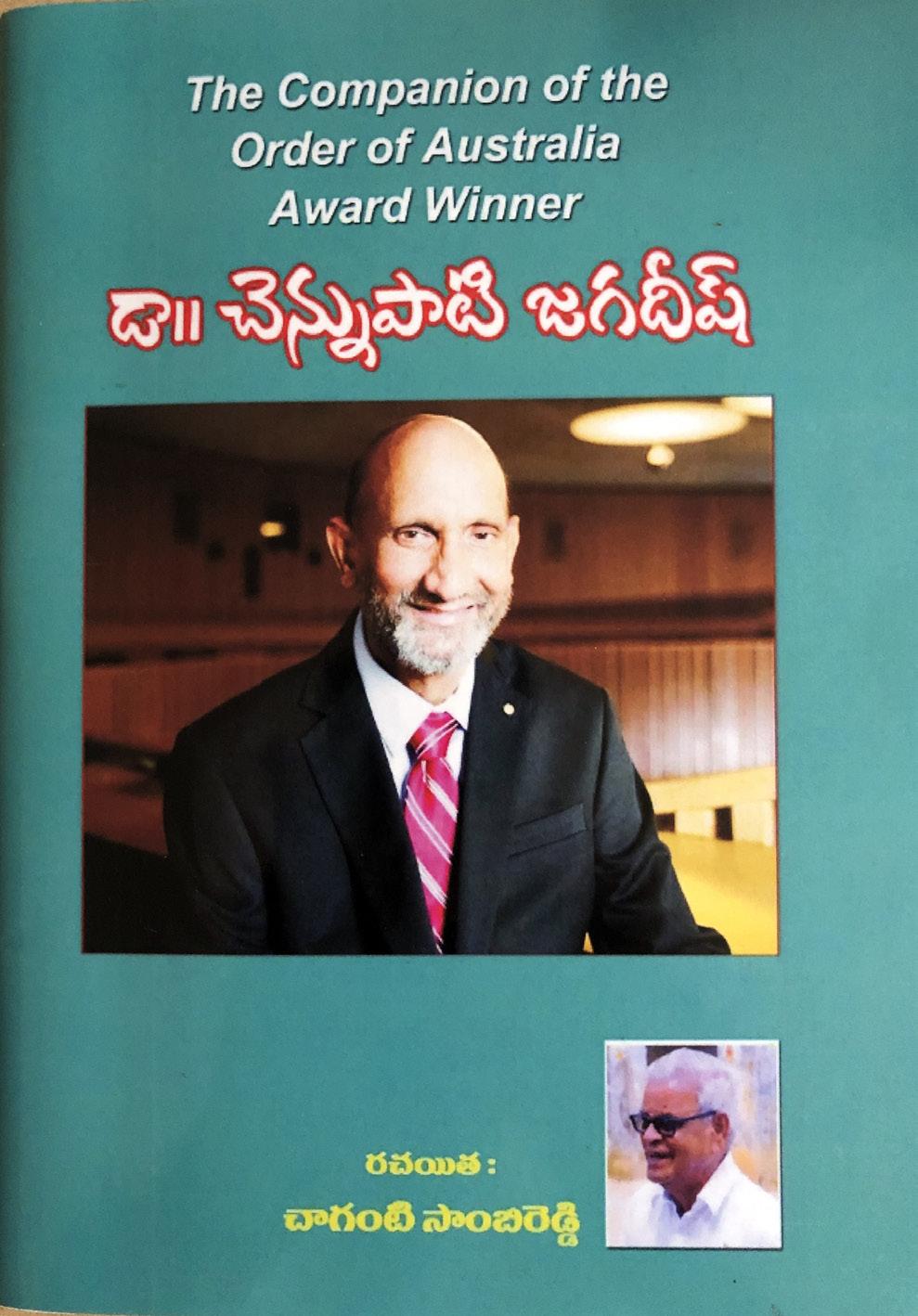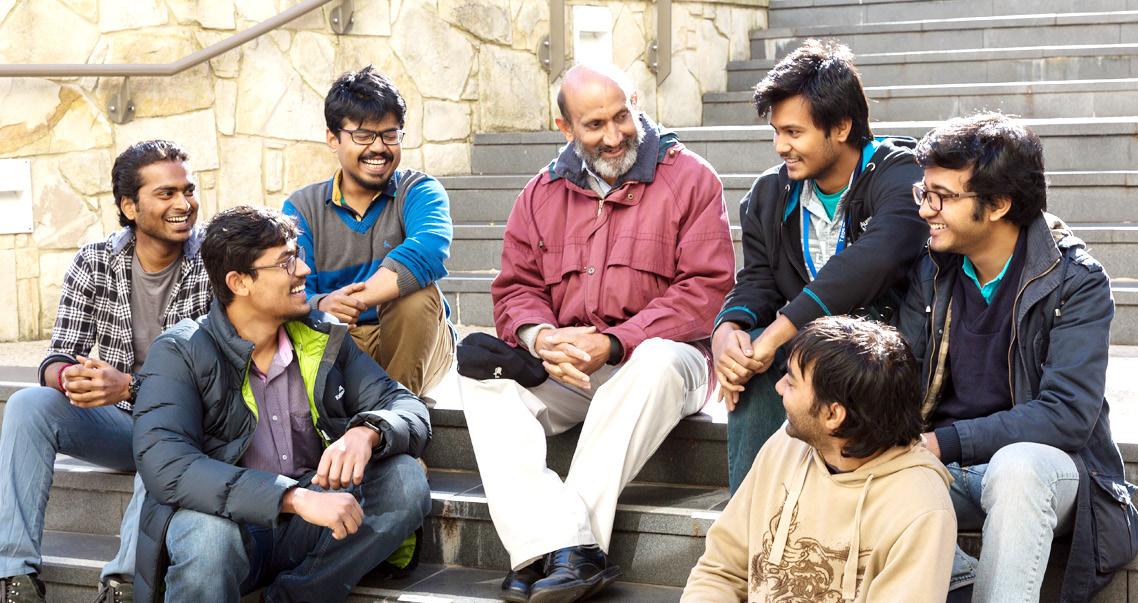
7 minute read
WHAT DRIVES Dr. Chennupati Jagadish
from 2023-01 Sydney
by Indian Link
ANU scientist becomes the latest Australian Pravasi Bharatiya Samman awardee
BY TORSHA SEN
T“he fact that the Government of India recognised me, a village guy from Andhra Pradesh, makes me grateful,” says Dr. Chennupati Jagadish, President of the Australian Academy of Science and professor of physics at the Australian National University.

He's talking about the Pravasi Bharatiya Samman, the highest Indian award for NonResident Indians and Overseas Citizens of India.
He received the honour from the President of India Ms Draupadi Murmu at the 17th Pravasi Bharatiya Diwas 2023 (PBD’23), held in Indore earlier this month.

Dr Jagadish is a leading researcher in the field of semiconductor physics and nanotechnology, with a focus on the growth and characterisation of semiconductor nanostructures.
One of Australia’s leading scientists, he has published over 700 research papers and is a fellow of the world’s leading science and technological institutions
Pravasi Bharatiya Samman



At PBD ’23, Dr Chennupati was one of 27 honourees from the world over. Speaking to Indian Link from the 3-day conclave, Dr Chennupati recounts, “It has been a humbling experience meeting with the Prime Minister of India over lunch and the External Affairs Minister at dinner, and then receiving the honour from the President of India.”
Of course, this latest honour is one of a long list of awards. His efforts were recognised by his adopted country way back in 2016 when the Australian Government bestowed on him the Companion of the Order of Australia (AC), awarded for eminent achievement and merit of the highest degree in service to Australia.

“I am grateful to both India and Australia,” Dr Chennupati observes. “One nurtured me from childhood to adulthood and provided me with education, whereas the other provided me the opportunity to prove myself as a scientist.”
The true scientist that he is, he takes pains to acknowledge colleagues and peers in his own scientific achievements.
“Science is a team effort; I have been fortunate enough to have had the opportunity to work with so many wonderful students, post-docs, young academics, and collaborators. I thank them for their contributions to our collective effort.”
ONE TEACHES, TWO LEARN
Other than his students, collaborators, and family, the 66-year-old scientist also pays homage to teachers that sparked it all in him.
Primary among these are his maths teacher from school, who holds a very special place in his journey and achievements.
“I wanted to study but didn’t have the means,” Dr Chennupati reveals.“My maths teacher supported me for three years, even offering me boarding and lodging, till I finished school. I remember him whenever I get an award.”
The maths teacher, Shri Chaganti Sambi Reddy, retired headmaster from Nunna, Vijaywada has written on the life and work of his favourite student, Chennupati Jagadish.

“It is students that write books about their teachers, not the other way round,” laughs Dr Jagadish. “How often do you see a teacher writing not one but two books about their student? It’s such an honour.”
He met with his 88-year-old teacher and mentor last year at the book launch.
As an educationist who believes in the ripple effect – ie, helping more for greater impact –Dr Chennupati makes sure he follows his revered teacher's footsteps in giving back to society.

“I am here because so many people especially opened various windows to the world for me. Today when I am in that position, I too want to do the same for as many students as I can,” shares the ANU professor.
To that end, his wife Vidya and he have initiated the Chennupati and Vidya Jagadish Visiting Scholarship and Fellowship Awards.

These give students and researchers from developing countries the chance to travel to the Research School of Physics at ANU to pursue collaborative research for up to 12 weeks.

“The success of this program has been overwhelming,” he reveals. “So much so that ANU has joined efforts and created Future Research Talent of ANU. This year we are ready to welcome 77 cohorts from developing countries, especially India.”
INDIA-AUSTRALIA A TERRITORY OF UNTAPPED POTENTIAL

Dr. Jagadish is optimistic about the huge potential in India-Australia relations, if directed the right way. “Both are vibrant democracies with similar value systems and there are enormous opportunities. Yet, we must go beyond the transactional way of thinking. I feel strongly the mindset of seeing the two countries in just unidirectional form of markets should change. We should go beyond the thought of ‘what am I going to get out of this?’ If that is what you are thinking, you have lost the plot.”
He adds, “A strong India-Australia relationship could be great for the entire
Indo-Pacific region in the long run. Long-term friendships can never be merely transactional.”
According to him, it’s never late for the two countries to collaborate. “In science alone, India and Australia have realised the potential, and are coming together in areas such as nanotechnology, semi-conductors, biotechnology, IT and so much more.”
He welcomes the latest move of India’s University Grants Commission (UGC) facilitating foreign universities to set up campuses in India. “The Australian education system is exceptional, and India has some of the greatest minds that need to become scientifically sound. It would be a great opportunity for educators if more students can be empowered that do not get the kind of exposure they deserve. In today’s world more and more STEM skills are required. Most industries are bound by STEM practices, therefore nurturing talent becomes a priority.”
Science Above All
And yet, we put to him, science education at school seems to be somewhat lacklustre.
“I am aware, and here is why science education is important. I feel when you have sound knowledge of the subject you can be confident in imparting it to others. Therefore, science-qualified teachers can make a huge difference. They can inspire students. Their deep background, the passion for science, and training in the subject can bring about a change,” says the Australian Academy of Science President.
WHAT ABOUT GIRLS IN SCIENCE?
“It’s definitely a problem that we don’t see as many girls or women in science as we should, and there are multiple factors. Perhaps we need more role models. Also, we need to highlight the works of women scientists a lot more than we do. Many of our women scientists have risen to the ranks with some excellent work. Australia’s Chief Defence Scientist Professor Tanya Monro AC, for instance, or Australia’s Chief Scientist Dr. Cathy Foley have both gone against all odds to be where they are today.”
He further shares, “Another problem that I am aware of is the leaky pipeline for women in science. A large number of women drop out due to family or social reasons which are not good.”
How is the Academy helping stem this leaky STEM pipeline?
“We are working on multiple structures that could begin to solve this problem. For starters, we have created STEM Women, an online directory of women in Australia working in STEM and provide opportunities to those who may experience barriers throughout their careers. We have taken it to the next level by connecting Asia-Pacific and globally with STEM Women Global Identity.”
What about the rise of a temperament away from or against science in the recent past, such as in the case of vaccines?
“Science can prosper when society accepts it and this is where STEM, Humanities, and Social Sciences need to work together. If you don’t understand the needs and issues, it would be very difficult to implement technology,” says Dr. Jagdish.
Dr. Jagadish arrived in Australia in 1990 as a young scientist with his wife Vidya, their two-month-old daughter, enormous scientific knowledge, and a handful of dreams that mostly revolved around empowering others. Today he is an acknowledged world leader in his particular research speciality.

“For students who are reading this and are passionate about science, let me tell you, don’t get trapped in misconceptions. If a village boy from Andhra can become the President of the Australian Academy of Science, then the sky is the limit,” concludes the newest Australian Pravasi Bharatiya Samman awardee.

BY RAJNI ANAND LUTHRA
-year-old Abhishek Verma admits to being surprised when he was announced as GP of the Year by the Royal Australian College of General Practitioners (RACGP).

“To be picked from amongst 40,000 GPs - many of who are older and more experienced, having practiced for decadeswas surprising,” he tells Indian Link. “But it was humbling - and I’m proud and grateful.”
It’s an honour he shares with Sydney’s Dr Anju Aggarwal.
The Melbourne born and raised Dr Verma has been practicing as a GP since 2016.
Currently he works at the Refugee Health Service at Collingwood, and previously worked at a family practice at Narre Warren.
Describing his current work he says, “As a mainstream GP I looked after patients who were health literate and had a good understanding of the process, and mostly had good outcomes. At Collingwood I gravitated towards recent migrants, refugees and asylum seekers, who couldn’t or wouldn’t find access to mainstream medical care. They need help to navigate the health system, and encouragement to get involved in their own health. As vulnerable people, they often end up with poorer health outcomes, and are the people most in need of our support. I am trying to contribute there. They are treated for free. Part of being a doctor is to make a difference in people’s lives. Small things can make a big impact, you know.”
Is that a different career choice as a doctor?
“It’s not as rewarding, but it’s meaningful,” he offers.
Seeing patients have good outcomes, is a career highlight according to him.
“To see depressed, withdrawn individuals go on to have happy functional lives with families of their own and productive careers, that’s meaningful. Or again, to work with a team of other health care professionals to see improved quality of life and better outcomes for patients, that’s meaningful.”
General Practice is not what he had planned, though.
“I was in surgical training for several years, actually. It’s very competitive. I was offered a position of ENT surgical trainee at rural Queensland. It didn’t suit my family at the time as my wife worked with PWC and we had just had a baby. So I switched to General Practice and took on a position at Melbourne.”

Perhaps he’s avoided the burnout that hospitals are said to have caused in Australia’s young doctors, which reached crisis levels last year.
“Yes,hospital work can take a toll on you - covering wards, emergency, then administrative duties, and that too with not a lot of support. But things are improving now, and we’re seeing greater emphasis on welfare.”
He should know, having inspired two younger brothers to










